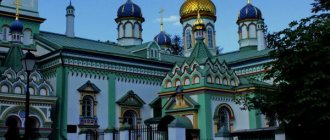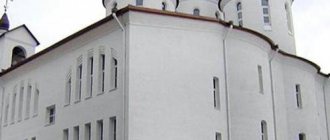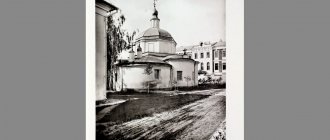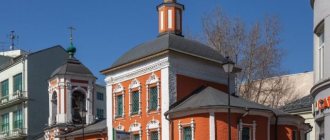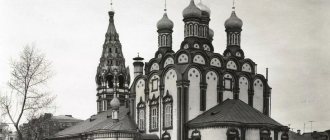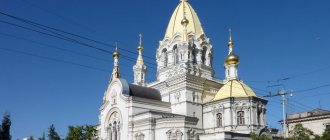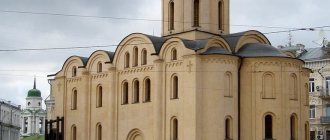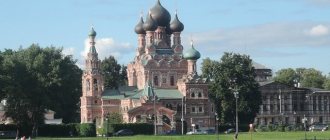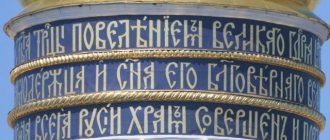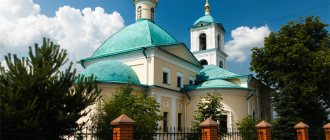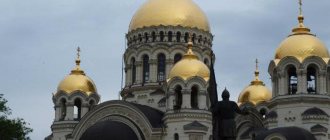This long-suffering church is somehow surprisingly located between three lanes: Novovogankovsky and two Trekhgorny. The Church of St. Nicholas on the Three Mountains has changed its name more than once over its centuries-old history and has been rebuilt several times. In the chronicles of 1628, its ancestor is mentioned - the Church of St. Nicholas in Psary. It received this name due to the transfer of the Royal Kennel Court here in the middle of the 17th century. This parish church community moved around the city several times, and, surprisingly, always took the church with them, which is probably why for some time it was called the “Church of St. Nicholas on a Chicken Leg.”
Church of St. Nicholas on the Three Mountains
In 1695, the Kennel Yard was located in the Three Mountains tract, behind the outpost called Trekhgornaya. Initially it was a wooden temple, then in 1762-1775 it was rebuilt in stone in the village of Novoye Vagankovo with three altars. The main one is in honor of the icon of the Mother of God “Life-Giving Spring”, two limits are in honor of St. Nicholas and St. Demetrius of Rostov. Over time, its boundaries gradually expanded, and in 1860 a high bell tower and a refectory were built, and the area of the property more than doubled.
The Church of St. Nicholas on the Three Mountains is an architectural monument of the 19th century and a cultural heritage site. There is a very interesting fact known about this structure. It turns out that in the 20s of the twentieth century A.V. served as regent here. Alexandrov, who became the author of the anthem of the Soviet Union.
The parishioners of the church were ordinary people, peasants and workers, but there were also quite wealthy people, including the Prokhorov manufacturers, who owned the Trekhgornaya manufactory.
All the extensions did not create a harmonious architectural ensemble, so it was decided to completely rebuild the church itself according to the design of the famous Russian architect G.A. Kaiser with the money of wealthy merchants Kopeikins-Serebryakovs, who lived in the parish of the church. On December 1, 1902, the renovated temple was consecrated. However, all construction and finishing work was finally completed only by 1908.
St. Nicholas Church
Temple in the 17th century
The history of the Church of St. Nicholas on the Three Mountains begins with the wooden church of St. Nicholas in Psary, mentioned in chronicles since 1628. Its name is associated with the Sovereign Psarny yard, which was responsible for hunting and the royal menageries, which in 1637 was transferred from the western wall of the Kremlin to Three mountains.
Metrics of the Church of St. Nicholas on the Three Mountains, in New Vagankovo. Opinions also differ about the origin of the name “Vagankovo”. According to legend, the tsar's Little Russian hounds used vagans - large troughs hollowed out in wood - to prepare food, for which they themselves were nicknamed vagans, and their place of residence was Vagankovo. Settlement on Presnya in the 17th century. was named New Vagankovo, and the settlement behind the Kutafya Tower remained Old Vagankovo.
True, there is another version of the origin of the toponym. This part of Moscow was located at the intersection of two major roads - Znamenka, leading to Novgorod, and Arbat, leading to the western lands. In the 15th century a village arose here, in which the Sovereign's amusement court was organized. Traveling artists and musicians, who were then called vagantes, flocked to him, just like wandering poet-bards in medieval Europe.
There is information that in 1695 the temple began to be rebuilt by the Duma clerk Gavriil Feodorovich Derevnin, who lived nearby, who also built the famous stone church of St. Elijah the Common on Ostozhenka.
XVIII – early XX centuries
In the first half of the 18th century. Three Mountains is becoming a summer cottage for wealthy Muscovites. Over time, rich “dacha residents” turn into permanent residents of New Vagankov and are assigned to St. Nicholas parish.
It was at this time that permission was received to build a stone church on the site of a wooden one: according to some sources it dates back to May 1763, according to others - 1762. In any case, the new temple was small. But in subsequent years it was expanded several times, adding chapels - first to St. Demetrius, Metropolitan of Rostov, and then, in 1785, in the name of the icon of the Mother of God “Life-Giving Source”.
In 1799, next to the St. Nicholas Church on the banks of the Moscow River, merchant Vasily Prokhorov and dyer Fyodor Rezanov founded a calico-printing factory, which over time became the famous Trekhgornaya Manufactory.
Vasily Ivanovich Prokhorov (1755-1815), merchant of the 3rd guild, founder of the dynasty of Moscow industrialists, was born into a peasant family assigned to the Trinity-Sergius Lavra. Until 1771 he worked as a brewing clerk. However, he left this occupation, “incompatible with Christian piety,” and took up calico printing. Over time, V.I. Prokhorov became the sole owner of the manufactory, buying out Fyodor Rezanov’s share.
Project for the reconstruction of the temple, architect Kaiser G.A., 1900. For almost a hundred years, until 1896, the Prokhorovs were ktitors and trustees of St. Nicholas Church. Their activities left a noticeable mark on the church life of Moscow. Industrialists also engaged in charity work, establishing hospitals and shelters for orphans and homeless people.
After the cholera epidemic of 1848, in gratitude for getting rid of it, it was decided to rebuild the St. Nicholas Church. By the end of 1860, the temple had a large refectory and a high bell tower, its area increased two and a half times. The construction was carried out with the money of parishioners.
In the second half of the 19th century. Through the tireless pastoral efforts of the rector, Archpriest Ruf Rzhanitsyn and his successor, Priest Evgeniy Uspensky, St. Nicholas parish became the largest in Moscow. Evening and morning services were performed in the church every day, and on Sundays and holidays three liturgies were served. The parish carried out active patronage and social activities. In 1861, a Board of Trustees was created at the temple, which collected information about poor parishioners and provided them with assistance. Father Ruf also founded the first two-year parish school for women in Moscow, by the beginning of the 20th century. Almost 90 pupils studied there.
Project of the northern façade, architect Kaiser G.A., 1900. The constant increase in the number of parishioners required another major reconstruction of the temple. It began in 1900 based on the project of the famous architect Georgy Alexandrovich Kaiser (1860-1931), approved personally by Emperor Nicholas II.
Funds for the work were allocated by the Kopeikin-Serebryakov family, owners of a large retail company. The rebuilt church was re-consecrated on December 1, 1902, but the reconstruction was completely completed only in 1908. The design of the G. A. Kaiser temple also formed the basis for restoration work in 1991-2000.
The events of 1905, the center of which was Presnya, as well as the October Revolution of 1917, miraculously did not affect the life of St. Nicholas parish. Its numbers remained stable, and order around the temple was maintained by the workers of Trekhgorka themselves - the parishioners of the temple.
XX-XXI century
In the spring of 1922, St. Nicholas Church, like all Moscow churches and monasteries, experienced a campaign to confiscate church valuables, losing more than 12 pounds of gold and silver objects. At this time, one of the regents of the temple was Alexander Vasilyevich Alexandrov, later the author of the USSR anthem and the founder of the Song and Dance Ensemble of the Soviet Army.
In 1928, the Church of St. Nicholas on Three Mountains, despite numerous requests from believers, was closed. By the end of 1930, the domes were removed from the church, openings were cut in the walls, and the upper tiers of the bell tower were dismantled. The building was adapted first as a House of Culture, and then as a House of Pioneers named after Pavlik Morozov.
On July 7, 1992, the Moscow Government adopted Resolution No. 472 on the provision of a plot of land in the village for permanent use. No. 9 on Pavlik Morozov Lane (now Novovagankovsky) to the parish of the Church of St. Nicholas on Three Mountains of the Moscow Diocese of the Russian Orthodox Church. Regular services resumed in 2001. A Sunday school was established at the church.
The especially revered shrines of the temple include a reliquary with a particle of the relics of St. Nicholas of Myra, taken out from the altar on Sundays and holidays, an icon of the Wonderworker with a particle of his relics, located in the St. Nicholas chapel, as well as an image of the Holy Martyr Tatiana with a particle of relics in the central part of the temple and an icon The Holy Great Martyr and Healer Panteleimon in the chapel of St. Demetrius of Rostov, written in 1909 in St. Andrew's Skete on Athos.
Since February 2016, the rector of the Temple has been Archpriest Dimitry Roshchin, who at the same time heads the department for work with public organizations at the Synodal Department of the Moscow Patriarchate for relations between the Church and society.
Church of St. Nicholas the Wonderworker
The same workers of the Trekhgornaya manufactory saved the church from disastrous destruction. In the most turbulent and dangerous years of 1905 and 1917, they organized the security of the cathedral, which was located right at the epicenter of all the revolutionary events that took place on Presnya. Thanks to this, the temple was not looted and destroyed.
However, in the early 20s, the church could not be saved; first it was destroyed, and then completely closed. In 1929 it was rebuilt; the dome and bell tower were destroyed. The new government placed a club there, and a little later the house of pioneers named after. Pavlik Morozova. The lane, which had the name Nikolsky, also began to bear the name of the pioneer hero.
Description
There is some disagreement regarding the architectural style to which the temple belongs. In general, we can say that the Church of St. Nicholas on Three Hills combines both the features of classicism, the main ones of which are the modesty and severity of details, and some features of the so-called “Moscow” baroque.
Interior of the Church of St. Nicholas
The long-awaited thaw
And now, after the collapse of the USSR, the Moscow government signed an order to return the building and its adjacent territory to the ownership of the Russian Orthodox Church.
The Church of St. Nicholas on the Three Mountains was immediately subjected to a major restoration and restored to its original beauty. Today it operates, even a Bible college, a Sunday school, and a club for the reconstruction of medieval folk cultures are open.
You can visit this temple at the address: Moscow, Novovagankovsky Lane, building 9, bldg. 1. The rector is now Archpriest Dmitry Roshchin, appointed on February 11, 2016.
History of construction
There is a rather interesting story connected with the Church of St. Nicholas, which became known not so long ago. The fact is that during the years of Soviet power, Alexander Alexandrov served in the temple with the rank of regent, who later became famous as the author of the anthem of the Soviet Union.
Church of St. Nicholas on Three Mountains, Moscow
It is worth noting that there are quite a lot of such amazing facts about the life of the temple. Today, the Church of St. Nicholas on the Three Mountains is an architectural landmark of the 19th century. It was built in the 18th century in the Three Mountains tract in the place where there once was a temple in Novy Vagankovo.
Gradually, the temple was upset and took on a different appearance from the original one; moreover, by the end of the 19th century, the temple and the temple area were increased several times. The stone temple already had three altars, and by the beginning of the 20th century a large refectory and a new bell tower were added to it.
Interesting! Due to the fact that the new buildings that appeared were quite different from the architecture of the church, at the beginning of the 20th century it was decided once again to completely rebuild it. The project of the new temple was developed by Georgy Kaiser, and in 1902 the church was completely rebuilt and consecrated.
However, the fate of the newly erected temple was predetermined - in the 20s the church was looted, and its building itself was rebuilt in such a way that it could be used for the needs of society. The bell tower and domes of the temple were completely destroyed; for many years, a club began to be located in this place of prayer, and then a House of Culture for children named after Pavlik Morozov.
Schedule of services
Matins Liturgy - starts at 8.00 (Wednesdays, Fridays and Saturdays). On major holidays and Sundays - starts at 9.00. The day before at 17.00 - Vespers. At 18.00 on Wednesdays the akathist to St. Nicholas the Wonderworker. At 8.00 on Sundays there is a prayer service and the water is blessed.
The commemoration of St. Nicholas takes place in the present time: September 11 is the birth of the saint, May 22 is the day of the transfer of his venerable relics, December 19 is the feast of honoring St. Nicholas.
The temple also has its own shrines. This is a casket with the relics of St. Nicholas of Myra of Lycia (for veneration it is taken out of the altar only at Sunday liturgies), as well as an icon of the Savior Not Made by Hands, an icon of St. Nicholas with the relics and the reliquary with the relics of St. Demetrius of Rostov.
HISTORICAL REFERENCE
| The parish of the Church of St. Nicholas the Wonderworker in Novy Vagankovo on Three Mountains has been known since 1683. The modern building of the three-altar church was built in 1902. Architect G.A. Kaiser. The main altar is in honor of the icon of the Mother of God “Life-Giving Source”. Chapels in honor of Saints Nicholas and Demetrius of Rostov. During the years of persecution, the parish was deregistered, and the church was closed for worship and transferred to the national economy in 1929. In 1992, the parish was revived and received legal registration. In the same year, the former church building was transferred to the parish. Since 2009, the synodal department of the Moscow Patriarchate for relations between the Church and society has been located at the temple, the chairman of which is the rector of the temple, Archpriest Vsevolod Chaplin. |
SACRED TEMPLE
The ark with the relics of St. Nicholas the Wonderworker, taken out from the altar for the veneration of believers at Sunday liturgies. Reliquary with the relics of St. Demetrius of Rostov; icon of the Savior Not Made by Hands; icon of St. Nicholas with relics.
WORSHIP
On Wednesday, Friday and Saturday, services (matins, hours, liturgy) begin at 8.00. On Sundays and great holidays, the Divine Liturgy begins at 9.00, the day before the all-night vigil - at 17.00. On Wednesdays at 18.00 akathist to St. Nicholas (except for days with services on the eve of great holidays and days of remembrance of the dead). On Sundays there is a prayer service with blessing of water at 8.00.
CLERGY
| Archpriest Dmitry Mikhailovich ROSCHIN, rector. On February 11, 2016 he was appointed rector of the temple |
| Archpriest Andrei Vadimovich LORGUS. Born March 25, 1956. Education: Moscow State University named after. M.V. Lomonosov. Moscow Theological Seminary. On June 26, 1988, he was ordained to the rank of deacon. December 6, 1993 - to the rank of presbyter. |
| Archpriest Dimitry Stanislavovich LIN. Born September 5, 1961. Education: Moscow Energy Institute. Candidate of Technical Sciences. Orthodox St. Tikhon's Theological Institute. On May 14, 1998, he was ordained to the rank of deacon. September 24, 2002 - to the rank of presbyter. |
| Priest Daniil Valerievich ZUBOV. Born June 29, 1976. Education: Education: Russian Academy of Physical Culture and Sports. Sretensky Theological Seminary. On August 8, 2004, he was ordained to the rank of deacon. May 13, 2008 - to the rank of presbyter. |
| Deacon Vadim Mikhailovich SAMOKHVALOV. Born November 20, 1977. Education: Moscow Institute of Public Utilities and Construction. Kolomna Theological Seminary. On February 26, 2012, he was ordained to the rank of deacon. |
| Deacon Andrey Nikolaevich TITUSHKIN |
DRIVING DIRECTIONS
The nearest metro stations are “Ulitsa 1905 Goda” (Tagansko-Krasnopresnenskaya line) and “Krasnopresnenskaya” (Circle line).
From the metro station "Ulitsa 1905 Goda"
: last car from the center, go along the ground pedestrian crossing to the opposite side of Presnensky Val Street, then to Krasnaya Presnya Street. Walk along Krasnaya Presnya Street about 200 meters to the ground pedestrian crossing, turn right, continue straight ahead to the intersection of Bolshoi Trekhgorny Lane and Bolshoy Predtechensky Lane. Cross Bolshoi Predtechensky Lane and turn left. Follow Bolshoi Predtechensky Lane until it intersects with Sredny Trekhgorny Lane. Turn right into Sredny Trekhgorny Lane and follow it to the Church of St. Nicholas on the Three Mountains.
From metro station "Krasnopresnenskaya"
: turn right and follow Krasnaya Presnya street away from the city center. Walk about 250 meters and turn left into Presnensky Lane. Walk to Zamorenova Street, cross it and turn right, follow to Prokudinsky Lane, walk along Prokudinsky Lane to B. Predtechensky Lane, turn right and walk to Sredny Trekhgorny Lane. Turn left and walk along Sredny Trekhgorny Lane to the Church of St. Nicholas on the Three Mountains.
In the parish of the temple there is a Sunday school for children and adults, the Organization of Russian Young Scouts (56th detachment of St. Nicholas), the Heritage Bible College, the historical reconstruction club named after. St. Demetrius Solunsky, club "Art'eria", groups of anonymous alcoholics, drug addicts and codependents work.
Church of St. Nicholas the Wonderworker in Novy Vagankovo
Built in 1762-85 in the “Three Mountains” tract, behind the Trekhgornaya outpost, in the settlement of Novoye Vagankovo on the site of a wooden church of the same name (1695). The royal hounds and buffoons, originally located in the settlement of Old Vagankovo (near the Kremlin), were resettled here in 1678. There are several versions of the origin of the word “vagankovo”: from “vaganit” - to amuse, joke; "Vaganets" - place of collection of cash tax; from “vagan” (“vazhan”) - residents of the Vyazhskaya region resettled to Moscow. In 1860, a new refectory and bell tower were built. Around 1892 the chapel of St. Nicholas the Wonderworker and St. Demetrius of Rostov was brought forward from the refectory in line with the main altar. In 1900-1902, at the expense of G.F. and N.F. Serebryakov, a new one was added to the old church with a main altar in honor of the icon of the Mother of God “Life-Giving Source” (architect G.A. Kaiser). Painted inside in 1908.
In 1922, the authorities removed St. 12 pounds of gold and silver jewelry and church utensils. Closed in 1929. Heavily rebuilt. The heads of the temple and the bell tower up to the first tier were destroyed, the second row of windows was broken in the refectory.
Until 1990, the building housed the House of Culture, then it was abandoned. In 1992 it was returned to the Russian Orthodox Church. Restoration work has begun. Worship services resumed in December 2000.
This church was first mentioned in 1683 in the settlement of New Vagankovo on Three Mountains, where, according to Moscow legend, the buffoons who originally lived in the settlement of Staroe Vagankovo, opposite the Kremlin behind Neglinnaya, were resettled. In 1695, a new wooden church was built to the east, closer to the Moscow River. After the construction of the Kamer-Collezhsky Wall, the temple was located within the boundaries of Moscow, at the Trekhgornaya Outpost. The stone three-altar church with a refectory and bell tower was erected in 1762–1785. The main altar is the icon of the Mother of God “Life-Giving Source”, the chapels in the refectory are St. Nicholas and Demetrius of Rostov. According to the old Moscow tradition, the temple continued to be called Nikolsky even in official documents. Built in the classicist style, it was completed with a rotundal dome, the side facades had classical porticoes.
In 1860, a new refectory and bell tower were built. Around 1892, the side chapels were moved from the refectory to the east, in line with the altar of the main church. In 1900–1902 a new main temple was built, funds for the construction of which were donated by G.F. and N.F. Serebryakovs. The design of the building and its interior decoration was created by the architect G.A. Kaiser. The consecration of the main altar in honor of the icon of the Mother of God “Life-Giving Source” took place on December 1, 1902. A magnificent five-tiered iconostasis was built, the icons were painted on a gold background, new utensils and new vestments were made on the icons. In 1908, the inside of the temple was painted.
The temple was closed in January 1930. For a long time the building was occupied by a children's club named after Pavlik Morozov. The domes of the temple and the bell tower were broken down to the first tier. They built a second floor in the refectory and broke through a second row of windows. In 1990, Pavlik Morozov's children's club moved out of the building, leaving a broken statue of the pioneer inside; the roof partially collapsed. In mid-1991, St. Nicholas Church was returned to the community of believers. Major reconstruction lasted almost ten years. As a result, the temple was returned to the appearance it had after the last pre-revolutionary restructuring in the early 1900s. Divine services resumed in 2001. Shrines of the temple: a particle of the relics of St. Nicholas, a revered 16th-century icon of the Savior Not Made by Hands, brought from the Church of the Apostle Andrew the First-Called, where Maria Mironova gave it after the death of her son, artist Andrei Mironov.
Mikhail Vostryshev. Moscow is Orthodox. All churches and chapels
The capital's church in honor of St. Nicholas the Wonderworker on Three Mountains in Novovagankovsky Lane will be restored and partially recreated according to its historical appearance.
As the chairman of Moskomekspertiza Valery Leonov , project documentation has already been agreed upon for the preservation and adaptation for modern use of the cultural heritage site “Temple in the Name of St. Nicholas the Wonderworker in New Vagankovo on the Three Mountains 1860, 1890s, 1900-1902, architect. G.A. Kaiser,” the department’s website reports.
– The temple in its current state is in need of reconstruction: the foundation of the church is deformed, there are cracks on the plinth, engineering communications require updating. There is also a significant loss of the original brick and white stone decoration. The agreed project provides for the return of the building to its appearance in 1917, noted the head of Moskomekspertiza.
During the work they plan to: dismantle later structures, fillings and finishings that distort the historical appearance of the facades; clean brick walls from late deposits; repair and rebuild later sections of the temple walls and create historical decorative elements from white stone.
As for the historical appearance of the temple, based on archival data, the craftsmen will recreate the octagonal dome and the upper tiers of the temple part. The trims and other decorative elements of the window frame will also be restored.
– As part of the internal work, it is planned to dismantle and reconstruct the historical iconostasis and icon cases, laying a new stone floor, repairing walls and vaults. For the city, as Moscow Mayor Sergei Sobyanin , it is extremely important to pay attention to the restoration of historical monuments to preserve history and provide assistance in the construction of churches, emphasized Valery Leonov.
The restored temple will be equipped for the convenience of people with disabilities. The temple area will also be improved, and the temple itself will be illuminated.
The Church of St. Nicholas on the Three Mountains is a cultural heritage site; it is located on the territory of the cultural layer “Village of the Three Mountains”. The current appearance of the temple is the result of a series of reconstructions and transformations.
The stone church “on the Three Mountains” was erected in 1762-1785 next to the wooden church, known since 1637. The temple was a quadrangle, topped with a dome on a wide drum, which was preceded by an elongated refectory and a three-tiered bell tower. In 1860, the refectory part of the temple was expanded, and therefore the bell tower was dismantled and rebuilt.
In 1900-1902, according to the design of the architect Georgy Kaiser , the quadrangle of the temple was rebuilt, and extensions were made to the lower tier of the bell tower. The new extensions were oriented towards the appearance of the refectory and bell tower of 1860 and were stylized to resemble ancient Russian architecture of the 17th century.
In the early 1990s, after the return of the Russian Orthodox Church, work was carried out to return the temple to its canonical church appearance.
From Monday to Saturday, Divine services begin at 8:00 - Matins, Hours and Liturgy.
On Sunday at 9:40 – the beginning of the Hours, at 10:00 – the beginning of the Liturgy.
The day before, on Saturday, there is an evening service at 17:00.
On Wednesday at 18.00 - St. Nicholas of Myra.
On Sunday at 9.00. - water-blessing prayer.
On the days of the Great and Twelfth Feasts, falling on Monday-Saturday, at 7:40 - the beginning of the Hours, at 8:00 - the beginning of the Liturgy. The day before, evening service - at 17:00.
At 19:00 on the 1st and 5th weeks of Great Lent - Divine services with reading of the Great Canon of St. Andrey Kritsky,
At 19:00 – Matins of Great Heel with reading of the 12 Passion Gospels
With the onset of Easter 2016, Divine services will be held daily.
Between three lanes: two Trekhgorny and one Novovagankovsky there is a long-suffering church. During its history, known to us since the 1620–1630s, it changed its name more than once and was rebuilt many times. Originally wooden, built by parishioners from the Sovereign's Kennel Yard, it was rebuilt in stone in 1762–1775. From then on, it expanded, chapels were added, and in 1860 it received a bell tower and a refectory, increasing in area two and a half times.
The parishioners and trustees of the temple were wealthy people, including the Prokhorov manufacturers, owners of the neighboring Trekhgornaya manufactory. The chaotic nature of the previous buildings and the increasing growth of parishioners required a new reconstruction. It was carried out in 1900–1902. designed by the architect Georgy Aleksandrovich Kaiser at the expense of large merchants Kopeikins-Serebryakovs, who lived in the parish of the church. After alterations, the church was re-consecrated in 1902, but the work was finally completed only in 1908.
At the beginning of the 20th century. Most of the parishioners were workers of the Trekhgornaya manufactory. In the turbulent years of 1905 and 1917, they took over the protection of the cathedral, which was at the epicenter of the revolutionary events on Presnya. And the temple was not damaged and was not looted.
In the 1920s one of the regents of the temple was Alexander Vasilyevich Alexandrov, the author of the USSR anthem.
The temple was closed in 1928. The church was beheaded, openings were made in the walls, and the top of the bell tower was dismantled. In the disfigured building there is a house of pioneers/house of culture named after. Pavlik Morozova. The lane, at that time called Nikolsky thanks to the church, was also named after the pioneer.
The temple was returned to believers in 1992. Restored in 1991–2000 according to the design of G.A. Kaiser. The church operates a Sunday school, a Bible college, a club for the historical reconstruction of medieval cultures, and the ArtAria center for contemporary art.
Moscow, August 24, 2022
Specialists will have to put in order not only the facades, but also the interiors of the church, including the unique painting of the iconostasis. Work will also be carried out in the refectory building and in the bell tower, according to the official website of the Moscow mayor.
The Church of St. Nicholas on the Three Mountains began to be restored. This complex of buildings in Novovagankovsky Lane is an example of neo-Russian (or pseudo-Russian) style. It is characterized by the use of elements of ancient Russian architecture and Byzantine architecture.
Throughout its history, the temple was rebuilt several times. The appearance it has now was formed in the mid-19th - early 20th centuries. Its distinctive feature is the pediments and platbands, reminiscent of Russian kokoshniks. The temple building, refectory and four-tier bell tower are built of brick. All facades are plastered and painted white.
The temple complex has not been restored for almost 30 years, and during this time it has become dilapidated and partially fallen into disrepair. Now it is necessary to put in order not only the facades, but also the interiors, including wall paintings and painting of the iconostasis. Restoration work will also be carried out in the refectory building and in the bell tower. Specialists will strengthen the foundation and brickwork of the walls, replace the roof and utilities, and also improve the surrounding area. At the moment, work has begun on clearing the facades of paint and old cracked plaster.
“The temple and its grounds have a rich history dating back almost four centuries. The first church on this site was wooden, it was built back in 1637. At the same time, it received its name in honor of St. Nicholas and the area in which it was located (Three Mountains). Almost a hundred years later, a small stone temple was erected in its place in the style of Moscow classicism, which was rebuilt several times in subsequent years, adding chapels. First, a chapel of St. Demetrius, Metropolitan of Rostov, was added, and then a chapel in the name of the “Life-Giving Source” icon of the Mother of God. In 1860, the refectory part of the temple was expanded. The new facades of the refectory and the four-tiered bell tower with a ball roof were built in the second half of the 19th century in the neo-Russian style,” said the head of the city Department of Cultural Heritage, Alexey Emelyanov.
According to him, the refectory and bell tower stood out from the general architectural ensemble. In 1908, it was decided to carry out a major reconstruction, stylizing the temple itself in a neo-Russian style. The project was created by the famous architect Georgy Kaiser. The current work was planned taking into account his developments.
Northern facade of the Church of St. Nicholas the Wonderworker on Novy Vagankovo. 1831 Reproduced from the book “Moscow. Photos from views of areas, temples, buildings and other structures.” Part IV. Publishing house "Moscow". 1886
During the Soviet years, the temple was not operational. The domes were removed, some of the windows were blocked up, and the building was adapted into a House of Culture. The situation changed in the 1990s: the temple reopened and restoration work was carried out.
The Church of St. Nicholas on the Three Mountains is an identified cultural heritage site. The restoration is carried out according to a project agreed with the Department of Cultural Heritage and under the supervision of department specialists. It is scheduled to be completed by the end of 2022.
This long-suffering church is somehow surprisingly located between three lanes: Novovogankovsky and two Trekhgorny. The Church of St. Nicholas on the Three Mountains has changed its name more than once over its centuries-old history and has been rebuilt several times. In the chronicles of 1628, its ancestor is mentioned - the Church of St. Nicholas in Psary. It received this name due to the transfer of the Royal Kennel Court here in the middle of the 17th century. This parish church community moved around the city several times, and, surprisingly, always took the church with them, which is probably why for some time it was called the “Church of St. Nicholas on a Chicken Leg.”
Reviews about the company
Unfortunately, no one has left comments on this page yet.
- Temple Saints
tel.
rector: Archpriest Vsevolod Chaplin
The Church of St. Nicholas the Wonderworker on Three Mountains is one of the most famous Moscow churches, an architectural monument of the 19th century.
The first mention of it dates back to the beginning of the 17th century, when the church was called St. Nicholas in Psary, in honor of the Psarny yard built nearby. Later the area received the name Vagankovo. The temple was made of wood for a long time; it was rebuilt in stone in 1762. Over the course of several years, two more chapels were added to it, in honor of St. Demetrius of Rostov and the icon of the Most Holy Theotokos “Life-Giving Spring.”
The temple was damaged during the Patriotic War of 1812, but was restored by the Prokhorov family, ktitors (trustees) of the temple. After the cholera epidemic in Moscow in 1848, the temple was rebuilt and expanded as a sign of gratitude to God. Under him, large-scale social activities were launched and the Board of Trustees for the Parish Poor was founded. Another major restructuring took place in the very first decade of the 20th century.
In 1928, the temple was closed, the dome was removed, additional windows were cut and the bell tower was dismantled, and the House of Pioneers named after Pavlik Morozov was founded here. The temple was returned to believers in 1992. The reconstruction lasted 9 years, services began in 2001. Since 2009, the Synodal Department of the Patriarchate for Relations between the Church and Society has been located at the temple, the chairman of which is the rector of the temple, Archpriest Vsevolod Chaplin.
The church that will be discussed in this article has changed its name and been rebuilt more than once. Located between three lanes - Novovagankovsky and Trekhgorny, the Church of St. Nicholas on Three Mountains, previously called the Church of St. Nicholas in Psary (because of the Tsar's Kennel Court, once located in these places), often moved around the city and therefore was popularly called the "Temple of St. Nicholas on chicken leg."
